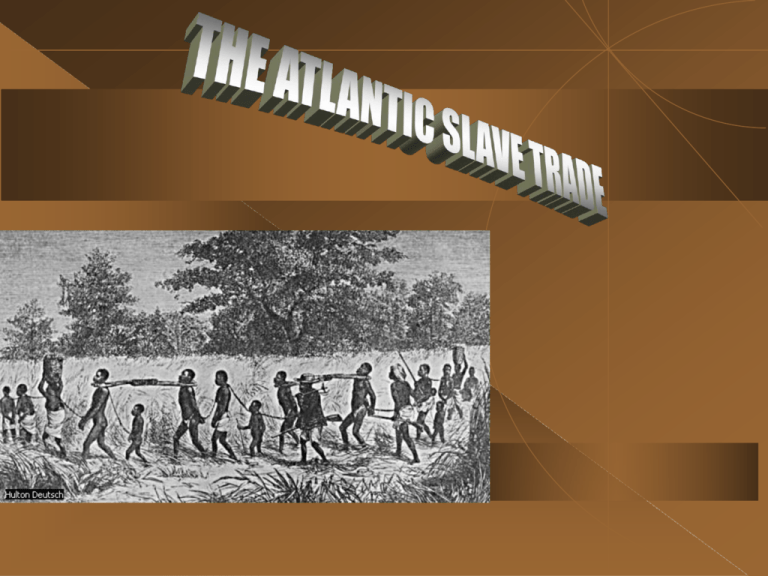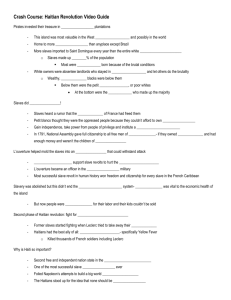
I. INTRODUCTION
1.
2.
3.
4.
Approximately 12 million enslaved
Africans were deported between the 15th
and 19th centuries.
Most slaves were sent to the Americas.
Slaves were exchanged for goods and
merchandise on Africa’s west coast.
The Slave Trade was the largest
intercontinental transfer of people prior to
the 20th century.
II. ROOTS OF THE ATLANTIC SLAVE
TRADE
1.
2.
3.
The Slave Trade began because of the
great demand for labor.
Plantations (large farms) became very
common, especially in the Americas.
These plantations produced sugar
cane, coffee, cocoa, rice, indigo,
tobacco and cotton.
II. ROOTS OF THE ATLANTIC SLAVE
TRADE
4.
Africans were seen as the ideal slaves for
several reasons:
A. Native Americans could easily escape
because of their familiarity with the land.
They also died from European diseases
such as small pox and measles, while
Africans had certain immunities for this
disease.
B. Africans also had immunities to certain
tropical diseases, such as malaria.
C. Indentured servants could easily escape
because they could blend in with the
European population.
III. CONDUCT OF THE SLAVE TRADE
1.
2.
3.
4.
For the most part, Europeans were only
shippers of the slaves.
Africans set up a very systematic way of
capturing slaves and trading them with
the Europeans.
Europeans would set up out-posts along
the western coast of Africa where they
would trade goods for slaves.
Slaves were exchanged for goods such
as cloths, metals, firearms, gun powder,
spirits, coins, horses and salt.
III. CONDUCT OF THE SLAVE TRADE
5.
6.
7.
8.
The Slave Trade became part of what
was known as the Triangle Trade.
In the first leg of the trade the Europeans
brought commodities down to Africa to
trade for slaves.
In the second leg the Europeans
transported the slaves to the Caribbean in
exchange for sugar, tobacco and cotton.
In the final leg the Europeans would sell
these goods in Europe and North
America.
TRIANGLE TRADE
IV. THE MIDDLE PASSAGE
1.
2.
3.
4.
5.
The Middle Passage was the voyage from
Africa to the Americas.
On average 16% of the slaves would die
during the passage.
Slaves were kept on deck most of the day.
Males were chained up while women and
children were given more freedom to roam.
Hygiene on board the ships was primitive.
Food and water were sometimes
contaminated and sanitary facilities were nonexistent.
Dysentery was the most common killer of
slaves during the Middle Passage.
THE MIDDLE PASSAGE
THE MIDDLE PASSAGE
V. THE FINAL DESTINATION
1.
2.
3.
4.
5.
About 10% of the slaves died during the
assimilation period.
Almost all slaves were exposed to heavy labor,
poor housing and insufficient medical care.
The harshest places for slaves to work were on
sugar plantations in the Caribbean.
The majority of slaves were sent to Central and
South America.
Only about 6% of the slaves ended up in the
United States.
“The men who fastened irons on the mothers took the children
out of their hands and threw them over the side of the ship into
the water. Two of the women leaped overboard after the
children…One of the two women…was carried down by the
weight of her irons before she could be rescued; but the other
was taken up by some men in a boat and brought on board. This
woman threw herself overboard one night when we were at
sea.”
What happened to each of the women above, and why
did it happen?
One woman drowned trying to save her baby after it was thrown
overboard. The other woman, who had also jumped overboard
VI. Cost of a Slave
• Slaves were expensive. As the years of slavery
passed, they became more expensive.
Regardless, white farmers, plantation owners,
and others bought slaves as an investment.
• A healthy 18-year-old slave could be bought for
$650 in 1845. (About $14,500 in today's dollars.)
• That same slave could be sold five years later
for $1,000. (About $21,000 in today's dollars.)
VI. ABOLITION OF THE SLAVE TRADE
1.
The Slave Trade was outlawed in Europe
and North America by 1820. There were
several reasons why this happened.
A. Changing economic conditions. Europe
and North America were beginning to
industrialize and the plantation system
became less important.
B. Humanitarian concerns became more
important during the Enlightenment.
VII. IMPACT OF THE SLAVE TRADE
TODAY
1.
2.
3.
4.
The Slave Trade made Africa dependent
upon Europe.
The Slave Trade stifled technological
advances in Africa.
It caused wars and conflicts in Africa.
There is a deep rooted problem of racism
based on the color of skin that still exists
today. This racism was highly encouraged
and promoted during the slave trade.
SOURCE
Microsoft® Encarta®
Encyclopedia 99. © 1993-1998
Microsoft Corporation. All rights
reserved.





